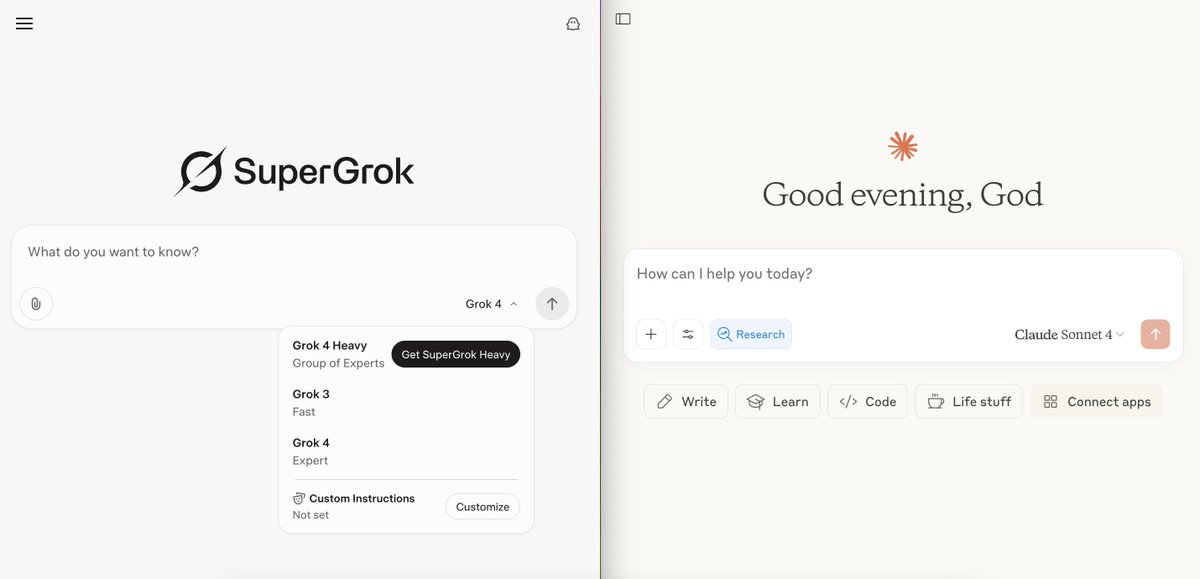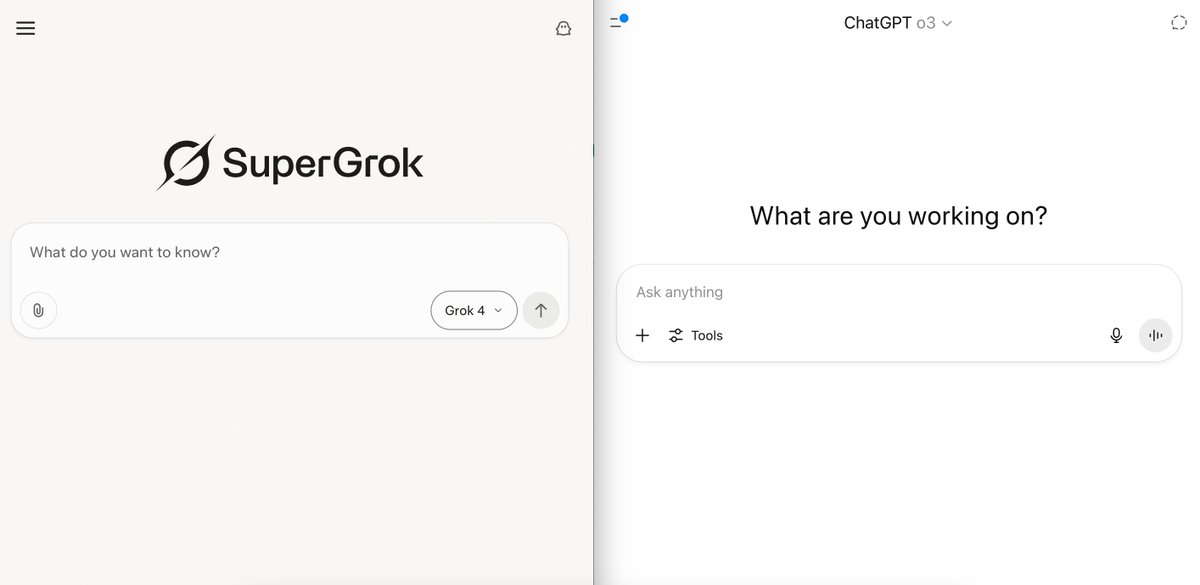The clash of AI titans: Grok 4 vs Claude 4
Which one is the best personal assistant for everything?
I ran 10 different tests on both models, and the results were mind-blowing.
You won’t believe who won.
(Demos + prompts inside) 👇
Which one is the best personal assistant for everything?
I ran 10 different tests on both models, and the results were mind-blowing.
You won’t believe who won.
(Demos + prompts inside) 👇

1. Solve a Logic Puzzle (Farmer Riddle)
Prompt:
“A farmer has a wolf, a goat, and a cabbage. He needs to cross a river with only one item at a time. How does he do it without anything getting eaten?”
What to expect:
Let’s see who can actually reason through puzzles like a human step by step.
Prompt:
“A farmer has a wolf, a goat, and a cabbage. He needs to cross a river with only one item at a time. How does he do it without anything getting eaten?”
What to expect:
Let’s see who can actually reason through puzzles like a human step by step.
2. Simplify Complex Research (Dead Internet Theory)
Prompt:
“Explain the ‘Dead Internet Theory’ in under 150 words like I’m a curious 12-year-old.”
What to expect:
Can they simplify complex ideas without sounding like robots?
Prompt:
“Explain the ‘Dead Internet Theory’ in under 150 words like I’m a curious 12-year-old.”
What to expect:
Can they simplify complex ideas without sounding like robots?
3. Write a Viral YouTube Script
Prompt:
“Write a short YouTube script (under 200 words) titled: ‘How I Used AI to Automate My Entire Side Hustle.’”
What to expect:
This one separates the AI who get content from the ones that just write.
Prompt:
“Write a short YouTube script (under 200 words) titled: ‘How I Used AI to Automate My Entire Side Hustle.’”
What to expect:
This one separates the AI who get content from the ones that just write.
4. Act Like a Professional Assistant
Prompt:
“Draft a polite email declining a meeting invite from a vendor, but leave the door open for Q4.”
What to expect:
Politeness, tact, and the ability to sound like a real exec assistant.
Prompt:
“Draft a polite email declining a meeting invite from a vendor, but leave the door open for Q4.”
What to expect:
Politeness, tact, and the ability to sound like a real exec assistant.
5. Do Chain-of-Thought Math
Prompt:
“If I invest $10,000 into a fund with 8% annual compound interest, how much will I have in 5 years? Show your reasoning.”
What to expect:
Time to test if they actually think or just throw numbers.
Prompt:
“If I invest $10,000 into a fund with 8% annual compound interest, how much will I have in 5 years? Show your reasoning.”
What to expect:
Time to test if they actually think or just throw numbers.
6. Generate a Prompt for AI image generation models
Prompt:
“Write a prompt to generate a surreal sci-fi cityscape with flying cars, neon lights, and vaporwave aesthetics. I will be using the prompt in different AI image generators like Midjourney, Flux, Google Gemini.”
What to expect:
Let’s see who understands aesthetics and prompt structure better.
Prompt:
“Write a prompt to generate a surreal sci-fi cityscape with flying cars, neon lights, and vaporwave aesthetics. I will be using the prompt in different AI image generators like Midjourney, Flux, Google Gemini.”
What to expect:
Let’s see who understands aesthetics and prompt structure better.
7. Summarize Legal Jargon Simply
Prompt:
“Summarize this short Terms of Service text in plain English for a teenager.”
(Insert real TOS block during testing)
What to expect:
Can they translate legal mumbo jumbo into something a 15-year-old would get?
Prompt:
“Summarize this short Terms of Service text in plain English for a teenager.”
(Insert real TOS block during testing)
What to expect:
Can they translate legal mumbo jumbo into something a 15-year-old would get?
8. Generate Python Code (Web Scraper)
Prompt:
“Write Python code to scrape the top 10 headlines from Hacker News using BeautifulSoup.”
What to expect:
Which model writes cleaner, working, well-commented code?
Prompt:
“Write Python code to scrape the top 10 headlines from Hacker News using BeautifulSoup.”
What to expect:
Which model writes cleaner, working, well-commented code?
9. Play Therapist for Burnout
Prompt:
“I’m feeling totally burnt out. Act as a therapist and walk me through 3 things I can do to feel better today.”
What to expect:
Real empathy vs generic advice who can talk like they care?
Prompt:
“I’m feeling totally burnt out. Act as a therapist and walk me through 3 things I can do to feel better today.”
What to expect:
Real empathy vs generic advice who can talk like they care?
10. Compare 2 SaaS Tools (Table Format)
Prompt:
“Compare Notion vs Coda for a startup founder looking to build an internal knowledge base. Output in a table.”
What to expect:
Structured, insightful, and practical let’s see who formats and thinks better.
Prompt:
“Compare Notion vs Coda for a startup founder looking to build an internal knowledge base. Output in a table.”
What to expect:
Structured, insightful, and practical let’s see who formats and thinks better.

I hope you've found this thread helpful.
Follow me @alex_prompter for more.
Like/Repost the quote below if you can:
Follow me @alex_prompter for more.
Like/Repost the quote below if you can:
https://twitter.com/1657385954594762758/status/1944052890659958829
The AI prompt library your competitors don't want you to find
→ Unlimited prompts: $15/month
→ Starter pack: $3.99/month
→ Pro bundle: $9.99/month
Grab it before it's gone 👇
godofprompt.ai/pricing
→ Unlimited prompts: $15/month
→ Starter pack: $3.99/month
→ Pro bundle: $9.99/month
Grab it before it's gone 👇
godofprompt.ai/pricing
• • •
Missing some Tweet in this thread? You can try to
force a refresh












